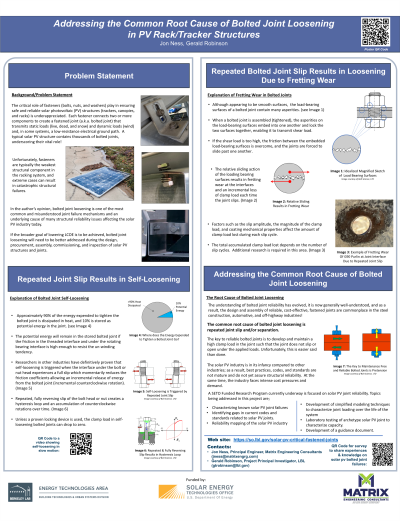Back

Electrification
Addressing the Common Root Cause of Bolted Joint Loosening in PV Rack/Tracker Structures
Addressing the Common Root Cause of Bolted Joint Loosening in PV Rack/Tracker Structures
Tuesday, September 12, 2023
4:30 PM - 5:30 PM PDT
Location: Poster Area, Booth #11024, Level 1, Venetian Expo Hall


Jon D. Ness, PE
Principal Engineer
Matrix Engineering Consultants
Eden Prairie, Minnesota, United States
Poster Presenter(s)
The critical role that fasteners (bolts, nuts, and washers) play in ensuring safe and reliable solar photovoltaic (PV) structures (trackers, canopies, and racks) is underappreciated. Each fastener connects two or more components to create a fastened joint (a.k.a. bolted joint) that transmits static loads (live, dead, and snow) and dynamic loads (wind) and, in some systems, a low-resistance electrical ground path. A typical solar PV structure contains thousands of bolted joints, underscoring their vital role!
Unfortunately, fasteners are typically the weakest structural component in the racking system, and extreme cases can result in catastrophic structural failures.
In the author’s opinion, bolted joint loosening is one of the most common and misunderstood joint failure mechanisms and an underlying cause of many structural reliability issues affecting the solar PV industry today.
If the broader goal of lowering LCOE is to be achieved, bolted joint loosening will need to be better addressed during the design, procurement, assembly, commissioning, and inspection of solar PV structures and joints.
Unfortunately, fasteners are typically the weakest structural component in the racking system, and extreme cases can result in catastrophic structural failures.
In the author’s opinion, bolted joint loosening is one of the most common and misunderstood joint failure mechanisms and an underlying cause of many structural reliability issues affecting the solar PV industry today.
If the broader goal of lowering LCOE is to be achieved, bolted joint loosening will need to be better addressed during the design, procurement, assembly, commissioning, and inspection of solar PV structures and joints.
